Top Rankings
Lowell Joint School District ranks among the top 20% of public school district in California for:
Category
Attribute
Community Size
Largest student body (number of students) (Top 1%)
For the 2025 school year, there are 6 public schools serving 3,029 students in Lowell Joint School District. This district's average testing ranking is 8/10, which is in the top 30% of public schools in California.
Public Schools in Lowell Joint School District have an average math proficiency score of 40% (versus the California public school average of 33%), and reading proficiency score of 56% (versus the 47% statewide average).
Minority enrollment is 83% of the student body (majority Hispanic), which is more than the California public school average of 80% (majority Hispanic).
Overview
This School District
This State (CA)
# Schools
6 Schools
10,369 Schools
# Students
3,029 Students
5,826,838 Students
# Teachers
129 Teachers
268,018 Teachers
Student : Teacher Ratio
23:1
23:1
District Rank
Lowell Joint School District, which is ranked #496 of all 1,925 school districts in California (based off of combined math and reading proficiency testing data) for the 2021-2022 school year.
Overall District Rank
#498 out of 1941 school districts
(Top 30%)
(Top 30%)
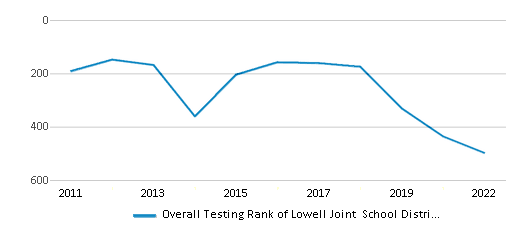
Math Test Scores (% Proficient)
40%
33%
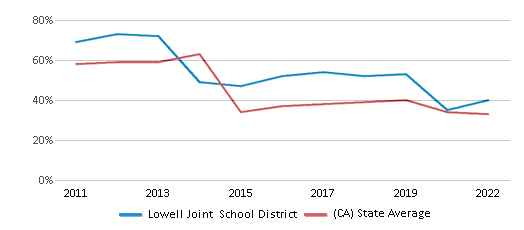
Reading/Language Arts Test Scores (% Proficient)
56%
47%
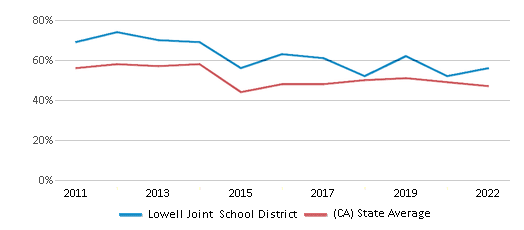
Science Test Scores (% Proficient)
37%
29%
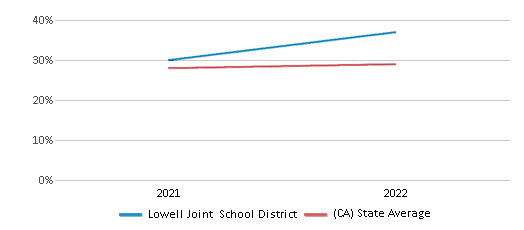
Students by Ethnicity:
Diversity Score
0.47
0.63
# American Indian Students
3 Students
25,796 Students
% American Indian Students
n/a
1%
# Asian Students
179 Students
705,807 Students
% Asian Students
6%
12%
# Hispanic Students
2,129 Students
3,264,561 Students
% Hispanic Students
71%
56%
# Black Students
36 Students
286,112 Students
% Black Students
1%
5%
# White Students
522 Students
1,178,558 Students
% White Students
17%
20%
# Hawaiian Students
6 Students
23,731 Students
% Hawaiian Students
n/a
n/a
# Two or more races Students
153 Students
333,755 Students
% of Two or more races Students
5%
6%
Students by Grade:
# Students in PK Grade:
-
83
# Students in K Grade:
434
522,456
# Students in 1st Grade:
308
396,605
# Students in 2nd Grade:
295
414,466
# Students in 3rd Grade:
309
416,628
# Students in 4th Grade:
291
426,361
# Students in 5th Grade:
319
430,587
# Students in 6th Grade:
331
432,997
# Students in 7th Grade:
346
439,621
# Students in 8th Grade:
396
441,777
# Students in 9th Grade:
-
466,534
# Students in 10th Grade:
-
476,585
# Students in 11th Grade:
-
469,511
# Students in 12th Grade:
-
492,627
# Ungraded Students:
-
-
District Revenue and Spending
The revenue/student of $13,708 in this school district is less than the state median of $19,974. The school district revenue/student has stayed relatively flat over four school years.
The school district's spending/student of $16,139 is less than the state median of $18,396. The school district spending/student has stayed relatively flat over four school years.
Total Revenue
$42 MM
$116,387 MM

Spending
$49 MM
$107,188 MM
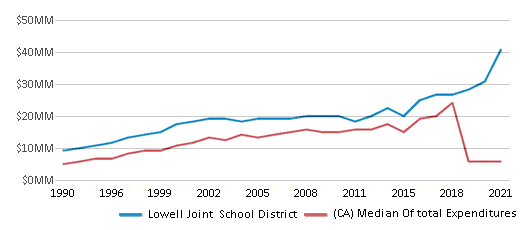
Revenue / Student
$13,708
$19,974
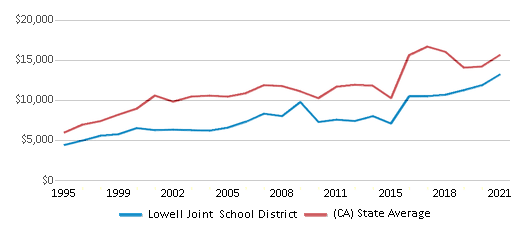
Spending / Student
$16,139
$18,396
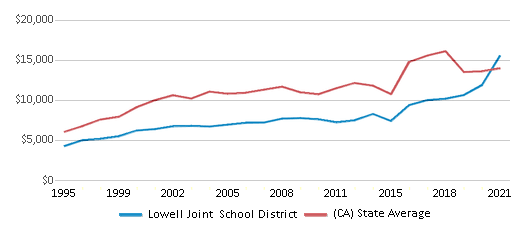
Best Lowell Joint School District Public Schools (2025)
School
(Math and Reading Proficiency)
(Math and Reading Proficiency)
Location
Grades
Students
Rank: #11.
Meadow Green Elementary School
(Math: 50% | Reading: 71%)
Rank:
Rank:
9/
Top 20%10
12025 South Grovedale Dr.
Whittier, CA 90604
(562) 902-4241
Whittier, CA 90604
(562) 902-4241
Grades: K-6
| 490 students
Rank: #22.
El Portal Elementary School
(Math: 52% | Reading: 58%)
Rank:
Rank:
8/
Top 30%10
200 North Nada St.
La Habra, CA 90631
(562) 902-4211
La Habra, CA 90631
(562) 902-4211
Grades: K-6
| 509 students
Rank: #33.
Macy Elementary School
(Math: 40% | Reading: 53%)
Rank:
Rank:
7/
Top 50%10
2301 West Russell St.
La Habra, CA 90631
(562) 902-4231
La Habra, CA 90631
(562) 902-4231
Grades: K-6
| 408 students
Rank: #44.
Rancho-starbuck Intermediate
(Math: 32% | Reading: 56%)
Rank:
Rank:
7/
Top 50%10
16430 Woodbrier Dr.
Whittier, CA 90604
(562) 902-4261
Whittier, CA 90604
(562) 902-4261
Grades: 7-8
| 738 students
Rank: #55.
Olita Elementary School
(Math: 42% | Reading: 46%)
Rank:
Rank:
7/
Top 50%10
950 South Briercliff Dr.
La Habra, CA 90631
(562) 902-4251
La Habra, CA 90631
(562) 902-4251
Grades: K-6
| 416 students
Rank: #66.
Jordan Elementary School
(Math: 38% | Reading: 45%)
Rank:
Rank:
7/
Top 50%10
10654 Jordan Rd.
Whittier, CA 90603
(562) 902-4221
Whittier, CA 90603
(562) 902-4221
Grades: K-6
| 468 students
Frequently Asked Questions
How many schools belong to Lowell Joint School District?
Lowell Joint School District manages 6 public schools serving 3,029 students.
What is the rank of Lowell Joint School District?
Lowell Joint School District is ranked #496 out of 1,925 school districts in California (top 30%) based off of combined math and reading proficiency testing data for the 2021-2022 school year. This district ranks in the top 20% of California school districts for: Largest student body (number of students) (Top 1%)
What is the racial composition of students in Lowell Joint School District?
71% of Lowell Joint School District students are Hispanic, 17% of students are White, 6% of students are Asian, 5% of students are Two or more races, and 1% of students are Black.
What is the student/teacher ratio of Lowell Joint School District?
Lowell Joint School District has a student/teacher ratio of 23:1, which is higher than the California state average of 22:1.
What is Lowell Joint School District's spending/student ratio?
The school district's spending/student of $16,139 is less than the state median of $18,396. The school district spending/student has stayed relatively flat over four school years.
Recent Articles

Year-Round Or Traditional Schedule?
Which is more appropriate for your child? A year-round attendance schedule or traditional schedule? We look at the pros and cons.

Why You Should Encourage Your Child to Join a Sports Team
Participating in team sports has a great many benefits for children, there is no doubt. In this article you will learn what those benefits are.

White Students are Now the Minority in U.S. Public Schools
Increasing birth rates among immigrant families from Asia and Central and South America, combined with lower birth rates among white families, means that for the first time in history, public school students in the United States are majority-minority. This shift in demographics poses difficulties for schools as they work to accommodate children of varying language abilities and socio-economic backgrounds.





